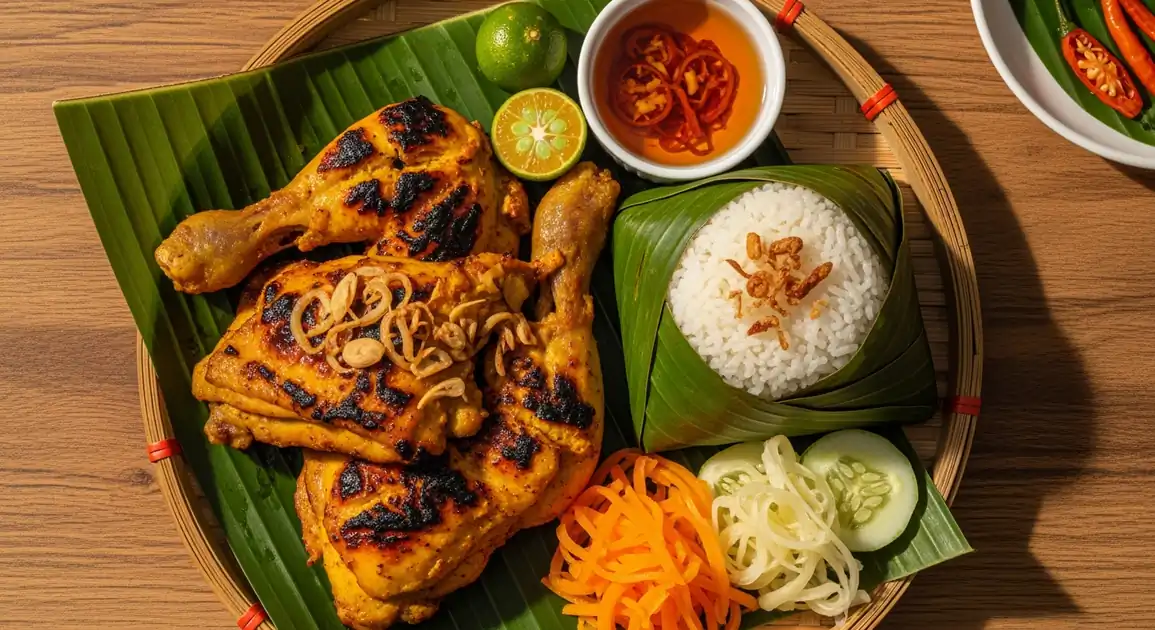Chicken Inasal
Inasal na Manok

Description
Throughout the Philippines, Chicken Inasal has become a beloved national dish, although it maintains strongest associations with its Western Visayas origins. While regional variations exist, Filipinos everywhere appreciate this iconic grilled chicken for its distinctive flavor profile and relative affordability.
Dietary Information
Serving information
Serving style
Typically served on bamboo, plastic, or banana leaf-lined plates with rice (often wrapped in banana leaf), a small dish of spiced vinegar (sinamak), slices of calamansi, and sometimes pickled green papaya (atchara). Many establishments provide plastic gloves for eating with hands.
Quick facts
Most inasal places operate from 10 AM - 10 PM, with peak hours during lunch (11 AM - 1 PM) and dinner (6 PM - 9 PM).
Safety Tips
What to Look For
-
Chicken being actively grilled, not sitting pre-cooked
Freshly grilled chicken minimizes bacterial growth and ensures proper cooking temperatures.
-
Clean grilling station with proper food handling
Observe if the vendor uses separate utensils for raw and cooked chicken and maintains a clean workspace.
-
Chicken cooked until juices run clear with no pink near bones
Properly cooked chicken reaches internal temperatures that kill harmful bacteria. The meat should not appear pink, especially near bones.
-
High customer turnover indicating freshness of ingredients
Popular stalls sell more chicken daily, meaning ingredients aren't sitting around for extended periods.
-
Staff wearing gloves when handling cooked food
This reduces chances of cross-contamination, though many authentic places may use clean bare hands as is traditional.
What to avoid
-
Pre-grilled chicken sitting at room temperature for long periods
Bacteria multiply rapidly on cooked meat at room temperature. Choose vendors who grill upon order or have proper warming setups.
-
Undercooked chicken with blood near bones
Undercooked chicken may contain harmful bacteria like Salmonella. Ensure meat is fully cooked through with no redness near bones.
-
Raw chicken stored next to or above cooked chicken
Cross-contamination can occur when raw chicken juices drip onto cooked items.
-
Dirty grilling area with visible flies or pests
Indicates poor hygiene practices that can contaminate food.
-
Reused marinade from raw chicken as sauce
Marinade used for raw chicken must be thoroughly cooked if served as sauce. Avoid places that appear to reuse raw marinade.
Price information
Price range
Budget tips
- Street food versions typically cost 80-150 PHP per serving with rice.
- Order 'pecho-pak' (breast-wing) combinations for better value at restaurants.
- Many places offer set meals ('meals') that include rice and a drink for 120-200 PHP.
- Chain restaurants like Mang Inasal often have unlimited rice promotions.
Value indicators
- Generous chicken portion size relative to price.
- Inclusion of traditional sides (sinamak vinegar, atchara, calamansi).
- Free soup (usually chicken broth) provided.
- Complimentary unlimited rice at some establishments.
- Additional chicken oil (annatto oil) available upon request.
Where to Find This Dish
Market Areas
Found in public markets and nearby food stalls in most cities.
Public Markets, Talipapa (small local markets)
Lunch, Dinner
Food Parks
Modern food parks in urban areas often include at least one inasal vendor.
Urban food parks, Outdoor dining complexes
Evening, Weekends
Commercial Districts
Found near office buildings and commercial centers catering to workers.
Business districts, Shopping malls
Lunch, After-work hours
Vendor Tips
- Ask locals for their recommended inasal places as quality can vary significantly.
- Request 'patiis' (chicken fat/oil) for authentic flavor on your rice.
- Some places offer unlimited rice ('unli-rice') - look for signs or ask.
How to Order
Regional Variations
-
Paa (Leg Quarter)
(Paa)
The leg quarter (thigh and drumstick) is one of the most popular cuts for inasal due to its juiciness and flavor retention during grilling.
-
Pecho (Breast)
(Pecho)
Chicken breast inasal is popular for those preferring leaner meat, though requires careful cooking to prevent dryness.
-
Pakpak (Wings)
(Pakpak)
Wing inasal is flavorful and popular as an appetizer or small portion.
-
Inasal sa Atay (Chicken Liver)
(Atay)
Grilled chicken liver prepared inasal-style, offering a rich, mineral flavor popular with adventurous eaters.
-
Spicy Inasal
(Maanghang na Inasal)
A variation with additional chili peppers in the marinade or basting mixture for a spicier flavor profile.
-
Lechon Manok Style Inasal
(Inasal na Lechon Manok)
A hybrid that incorporates elements of both traditional inasal and the rotisserie-style lechon manok cooking method.
Cultural context
History
Chicken Inasal originated in the Western Visayas region of the Philippines, with both Bacolod City and Iloilo claiming roots to this beloved dish. The term 'inasal' comes from the Hiligaynon word meaning 'chargrilled' or 'roasted meat.' What began as humble street food in the 1970s has evolved into a national Filipino favorite, with legendary establishments like the original vendors at Bacolod's Manokan Country helping to popularize it nationwide. The dish represents the Filipino talent for creating vibrant flavors from simple, accessible ingredients.
Local significance
Chicken Inasal represents Filipino culinary ingenuity, transforming simple ingredients into distinctive flavors. It embodies the festive spirit of Filipino dining and the importance of grilling in Filipino food culture.
Eating customs
- Squeeze calamansi over the chicken before eating.
- Mix vinegar with soy sauce and chili for a personalized dipping sauce.
- Use banana leaf-wrapped rice for authentic experience.